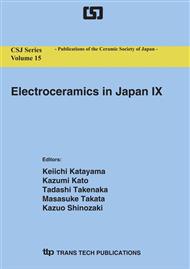p.143
p.147
p.151
p.155
p.159
p.163
p.167
p.171
p.175
Preparation and Characterization of Porous Alumina Film Using Sol Containing PEG
Abstract:
To obtain porous alumina films, the precursor sol was prepared by hydrolysis of Al isopropoxide and then mixing with poly(ethylene glycol) (PEG). The porous alumina films were fabricated by dip-coating technique on glass substrates and heating at 500 °C. The film was composed of nano sized particles (30-50 nm). The maximum thickness of the film prepared by one-run dip-coating was ca. 1000 nm. The film had humidity-sensitive electrical resistance at room temperature.
Info:
Periodical:
Pages:
159-162
Citation:
Online since:
September 2006
Authors:
Price:
Сopyright:
© 2006 Trans Tech Publications Ltd. All Rights Reserved
Share:
Citation:


